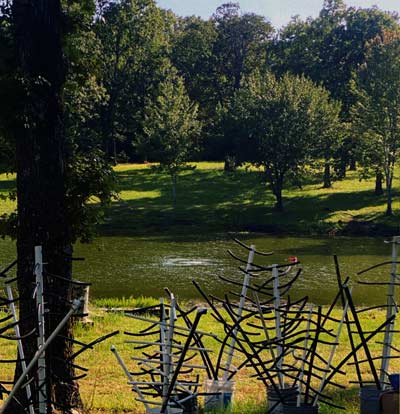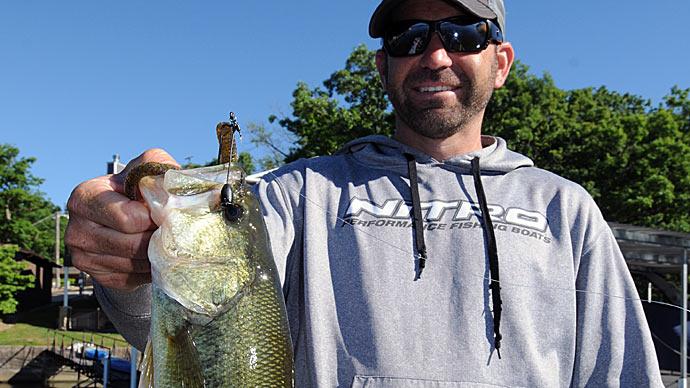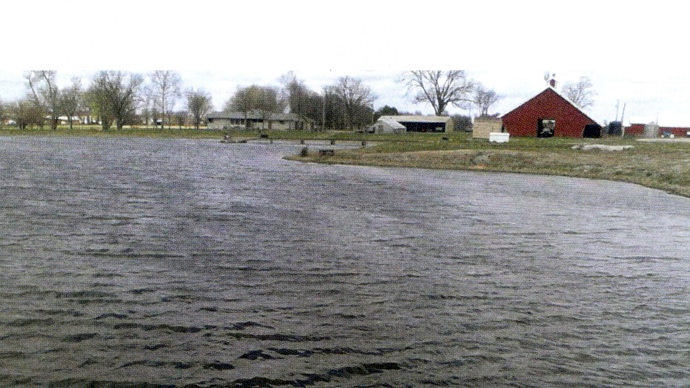
I got to spend time with Dr. Mark Williams at his place near Mountain Home, Arkansas. You know guys like Mark...you may be one of them.
He studied topo maps, looked at the Pond Boss forum, asked a plethora of questions, pored over the real estate listings, and shopped land. His biggest criteria were to buy land and build a nice-sized pond.
Mark Williams is our kind of guy. Find the land where a pond would work. The house and other stuff could come later.
He researched hydrology, watershed sizes, and dirt. Lots about dirt. Red clay, gray clay, dam building.
The land was there; he found it and started his planning phase. Part of the fun was working with the father-son team who built his five-acre lake. They pushed and shoved dirt, rearranged it, stockpiled rocks dredged up from the site, and built his dam.
They placed the rocks where he wanted them for fish habitat.
Two weeks after the dam was finished, in late September 2002, the rains came. Floods, actually. His pond rose to the brim, and he was ready for fish.
He'd not thought much about how to stock it. He didn't expect it to fill so quickly. He leaned on the state game and fish commission for advice. They had a local fisheries biologist willing to offer advice.
That was also the year Arkansas stopped giving free fish to private pond owners.
He was the last guy to get those free fish. He was able to borrow a fish transport tank from the state and headed to the state hatchery in Lonoke. He got the last of the fish headed for freedom.
Hatchery personnel were happy to finish up for the fall and provide Mark with what they had left. He had no idea of the numbers but knew he got a mix of bluegills, redear sunfish...and bass. He headed home, stocked the fish, and wished them luck.
After that little excursion, pretty pleased with himself and his turn of fish fortune, he spent more time on the forum and started questioning himself and the number of fish stocked. He didn't know how many of what species or the actual sizes.
Being a meticulous-natured guy, not knowing the numbers started bothering him, as he studied his way into what he should have done.
The game and fish staff biologist stopped by a few times to see how the lake looked and get an idea of its production. The state even electro-fished for him a couple of times...even though they didn't broadcast that back in that day and time. They also told him how to fertilize the pond slowly with buckets drilled full of holes to release granular fertilizer over a long period.
He watched his fish grow and was pretty happy, but was still scratching his head over the numbers.
He didn't know how many fish he stocked.
It didn't take long for him to see that the bass were too early out of the gates and overgrazing his food chain. Bass were quickly overcrowded and his food chain was inadequate. He was queasy about culling underweight bass and just tossing them on the bank, as most of us are.
For years, he's battled overcrowded bass.
Over time, he's adjusted and has had local friends come to catch fish for charity fish fry events. He's added forage fish and managed aquatic plants.
But he still thinks he messed up his original stocking because he just took what was available, not so much the best number of each, staged at the right time of the year. Has he caught some nice fish? Absolutely.
He's had a great time with it and caught some bass up to 8.7 pounds. With all the stuff life throws at us, his pond has been a key part of his joy and peace and the science behind his management strategy.
He said, "My pond is my refuge".
As he reflects, he knows he should have spent more time researching and planning his stocking rates and sizes.
Are you ready to start your stocking plan? Know what you are going to do? Make a plan. Build your food chain first.
So, what does that mean?
Think about your goals. Are you in a hurry? Got time? Timeline influences your plan. So does your budget.
Think about it this way. However you do it, build the food chain well before stocking game fish. Learn about each of your prey species and provide what they need to be able to grow up, reproduce, thrive, eat, and fill the water with young.
If time is an issue, and you want your fishery to mature quicker, stock a variety of sizes of bluegills, if that's your primary backbone prey. Fathead minnows reproduce like little underwater rabbits if they have a place...and are not overly grazed by too many fish that like to eat baby fathead minnows.
See where I'm going?
Think through your plan and stage your stocking based on the time of the year and your goals. Time your bass (or other predator fish) stocking based on when the prey base is ready. Don't stock predator fish prematurely. But don't wait too long, either—timing, timing, timing.
If you have any doubts, be comfortable sampling your prey base before adding bass. You'll often see a handful of surprises... fewer fish than you thought.... or more than you thought.
Stage your fish stocking thoughtfully. Forage fish, first.
Give them time to do what they do, reproducing, growing, and maturing. Think "mass" ...you want a bunch of pounds of baitfish to support your young bass as they grow.
Remember, a game fish takes about ten pounds of baitfish to gain one pound more as they age. You are in the forage fish business.
Even today, 21 years later, Mark says, "I wish I'd staged my stocking."
Reprinted with permission from Pond Boss Magazine



